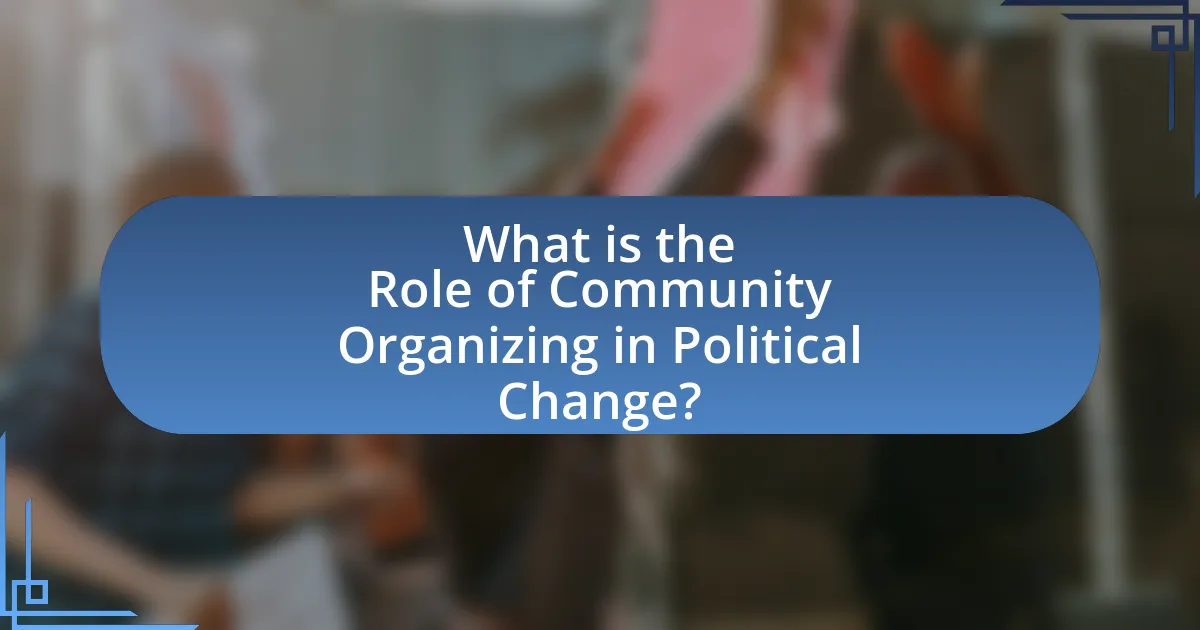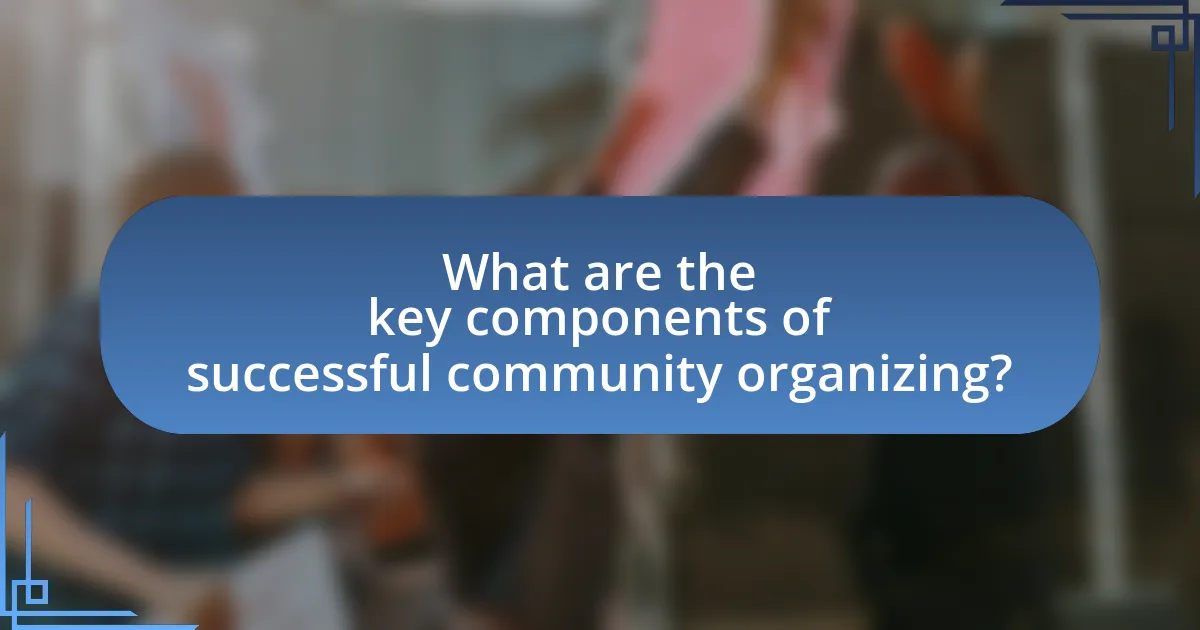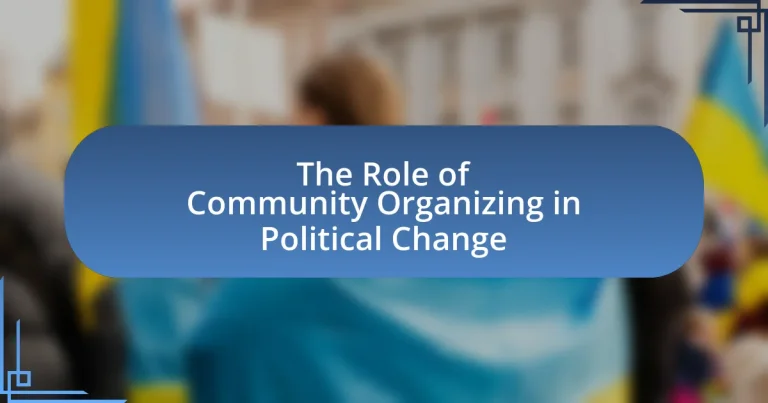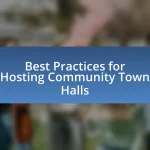Community organizing is a grassroots approach that plays a vital role in driving political change by mobilizing individuals to collectively address social issues and influence policy decisions. This article explores the significance of community organizing in political movements, highlighting key strategies such as building relationships, mobilizing resources, and fostering leadership development. It examines historical examples, including the Civil Rights Movement, to illustrate how organized efforts can lead to substantial legislative reforms. Additionally, the article discusses the challenges faced by community organizers, the impact of technology and social media, and best practices for enhancing the effectiveness of organizing efforts in achieving political change.

What is the Role of Community Organizing in Political Change?
Community organizing plays a crucial role in political change by mobilizing individuals to collectively address social issues and influence policy decisions. This grassroots approach empowers communities to identify their needs, build leadership, and advocate for their interests, often leading to significant legislative reforms. For instance, the Civil Rights Movement in the United States exemplified how organized community efforts resulted in landmark legislation such as the Civil Rights Act of 1964 and the Voting Rights Act of 1965, demonstrating the effectiveness of community organizing in achieving political change.
How does community organizing influence political movements?
Community organizing significantly influences political movements by mobilizing individuals around shared interests and goals, fostering collective action. This grassroots approach empowers communities to advocate for policy changes, as seen in the Civil Rights Movement, where organizations like the Student Nonviolent Coordinating Committee (SNCC) galvanized local populations to demand equal rights, leading to landmark legislation such as the Civil Rights Act of 1964. Additionally, community organizing builds networks of support and resources, enhancing the capacity of movements to challenge established power structures effectively.
What are the key strategies used in community organizing for political change?
Key strategies used in community organizing for political change include building relationships, mobilizing community members, and leveraging collective power. Building relationships fosters trust and collaboration among community members, which is essential for effective organizing. Mobilizing community members involves educating them about issues, encouraging participation in advocacy efforts, and facilitating grassroots campaigns. Leveraging collective power means uniting individuals to amplify their voices, often leading to significant political influence, as seen in movements like the Civil Rights Movement, where organized communities successfully challenged systemic injustices. These strategies are foundational for achieving political change through community organizing.
How do grassroots efforts contribute to larger political agendas?
Grassroots efforts contribute to larger political agendas by mobilizing community members to advocate for specific issues, thereby influencing policy decisions and political discourse. These local movements often serve as a foundation for broader political change by raising awareness, building coalitions, and applying pressure on elected officials. For example, the Civil Rights Movement in the United States utilized grassroots organizing to challenge systemic racism, leading to significant legislative changes such as the Civil Rights Act of 1964. This demonstrates that grassroots initiatives can effectively shape and align with larger political goals, ultimately driving societal transformation.
Why is community organizing essential for effective political change?
Community organizing is essential for effective political change because it mobilizes individuals to collectively address shared issues, amplifying their voices and demands. This grassroots approach fosters a sense of agency among community members, enabling them to influence policy decisions and hold leaders accountable. Historical examples, such as the Civil Rights Movement, demonstrate that organized communities can successfully challenge systemic injustices and achieve significant legislative reforms, such as the Voting Rights Act of 1965. By building networks of support and solidarity, community organizing creates a powerful platform for advocating change, ensuring that diverse perspectives are represented in the political process.
What historical examples illustrate the impact of community organizing?
Historical examples that illustrate the impact of community organizing include the Civil Rights Movement in the United States and the labor movement in the early 20th century. The Civil Rights Movement, led by figures such as Martin Luther King Jr. and organizations like the Southern Christian Leadership Conference, mobilized communities to challenge racial segregation and discrimination, resulting in landmark legislation like the Civil Rights Act of 1964. Similarly, the labor movement organized workers to advocate for better working conditions and fair wages, leading to significant reforms such as the establishment of the Fair Labor Standards Act in 1938, which set minimum wage and overtime pay standards. These examples demonstrate how community organizing can effectively mobilize collective action to achieve substantial political and social change.
How does community organizing empower marginalized groups in politics?
Community organizing empowers marginalized groups in politics by providing them with the tools and platforms necessary to amplify their voices and influence decision-making processes. Through collective action, these groups can identify common issues, mobilize resources, and advocate for policy changes that reflect their needs and interests. For instance, the Civil Rights Movement in the United States demonstrated how grassroots organizing led to significant legislative changes, such as the Voting Rights Act of 1965, which aimed to eliminate racial discrimination in voting. This historical example illustrates that organized efforts can lead to tangible political power and representation for marginalized communities.

What are the key components of successful community organizing?
The key components of successful community organizing include building relationships, identifying shared goals, mobilizing resources, and fostering leadership development. Building relationships among community members creates trust and collaboration, which are essential for effective organizing. Identifying shared goals aligns the community’s efforts and ensures that all members are working towards a common purpose, enhancing collective action. Mobilizing resources, such as funding, volunteers, and materials, is crucial for implementing initiatives and sustaining efforts over time. Fostering leadership development empowers individuals within the community to take initiative and lead efforts, ensuring the sustainability of organizing efforts. These components are supported by historical examples, such as the Civil Rights Movement, where strong relationships and shared goals led to significant political change.
How do leadership and mobilization play a role in community organizing?
Leadership and mobilization are critical components of community organizing, as they drive collective action and empower individuals to effect change. Effective leadership provides vision, direction, and motivation, enabling community members to unite around common goals. Mobilization translates this leadership into action by organizing resources, coordinating efforts, and engaging participants in activities that promote social and political change. For instance, successful community organizing campaigns, such as the Civil Rights Movement, relied on strong leaders like Martin Luther King Jr. to inspire and mobilize individuals, resulting in significant legislative changes like the Civil Rights Act of 1964. This demonstrates that leadership and mobilization are essential for transforming community aspirations into tangible political outcomes.
What qualities define effective community leaders?
Effective community leaders are defined by qualities such as strong communication skills, empathy, integrity, and the ability to mobilize and inspire others. Strong communication skills enable leaders to articulate their vision and engage community members effectively, fostering collaboration. Empathy allows leaders to understand and address the diverse needs of their community, building trust and rapport. Integrity ensures that leaders act ethically and transparently, which is crucial for maintaining community support. The ability to mobilize and inspire others is essential for driving collective action and achieving common goals, as evidenced by successful community organizing efforts that have led to significant political change, such as the Civil Rights Movement, where leaders like Martin Luther King Jr. effectively galvanized public support through these qualities.
How can mobilization strategies enhance community engagement?
Mobilization strategies enhance community engagement by actively involving community members in decision-making processes and collective actions. These strategies, such as grassroots organizing and participatory planning, empower individuals to voice their concerns and contribute to solutions, fostering a sense of ownership and responsibility. Research indicates that communities engaged through mobilization efforts experience increased civic participation; for instance, a study by the National Civic League found that neighborhoods with strong mobilization initiatives saw a 30% rise in voter turnout compared to those without such efforts. This evidence underscores the effectiveness of mobilization strategies in strengthening community ties and promoting active involvement in local governance.
What tools and resources are available for community organizers?
Community organizers have access to various tools and resources that enhance their effectiveness in mobilizing and advocating for change. Key tools include digital platforms like social media for outreach, online petition services such as Change.org for gathering support, and project management software like Trello for organizing tasks. Resources also encompass training programs offered by organizations like the Midwest Academy, which provides workshops on organizing strategies, and funding opportunities from foundations that support grassroots initiatives. Additionally, community organizers can utilize data analytics tools to assess community needs and measure impact, ensuring their efforts are informed and targeted.
How can technology facilitate community organizing efforts?
Technology facilitates community organizing efforts by providing platforms for communication, mobilization, and resource sharing. Digital tools such as social media enable organizers to reach a wider audience quickly, allowing for the rapid dissemination of information and coordination of events. For instance, during the Arab Spring, social media platforms played a crucial role in organizing protests and sharing real-time updates, demonstrating how technology can amplify grassroots movements. Additionally, tools like crowdfunding websites allow communities to raise funds for initiatives, further empowering local efforts. These technological advancements enhance the efficiency and effectiveness of community organizing, ultimately contributing to political change.
What role do social media platforms play in political mobilization?
Social media platforms play a crucial role in political mobilization by facilitating communication, organization, and engagement among individuals and groups. These platforms enable users to share information rapidly, coordinate events, and rally support for political causes, significantly impacting voter turnout and activism. For instance, during the Arab Spring, social media was instrumental in organizing protests and disseminating information, leading to significant political changes in several countries. Additionally, studies show that social media campaigns can increase political participation; a 2018 study published in the American Economic Journal found that targeted social media ads can boost voter turnout by as much as 0.5%.

What challenges do community organizers face in political change?
Community organizers face significant challenges in political change, including limited resources, resistance from established political structures, and difficulties in mobilizing diverse community members. Limited funding and manpower hinder their ability to effectively advocate for change, as evidenced by studies showing that grassroots organizations often operate on tight budgets, which restricts outreach and campaign efforts. Additionally, established political entities may resist changes proposed by community organizers, viewing them as threats to the status quo. This resistance can manifest in bureaucratic obstacles or outright opposition, complicating the organizers’ efforts to implement their agendas. Furthermore, mobilizing a diverse group of community members can be challenging due to differing priorities, cultural barriers, and varying levels of engagement, which can dilute collective action and weaken the impact of their initiatives.
How do funding and resource limitations affect community organizing?
Funding and resource limitations significantly hinder community organizing by restricting the ability to mobilize, communicate, and sustain efforts. Limited financial resources reduce the capacity to hire staff, conduct outreach, and organize events, which are essential for effective community engagement. For instance, a study by the National Committee for Responsive Philanthropy found that organizations with inadequate funding often struggle to maintain consistent programming, leading to decreased community participation and diminished impact on political change. Additionally, resource constraints can limit access to necessary tools and technologies, further impeding the ability to organize effectively and advocate for policy changes.
What strategies can organizers use to overcome financial barriers?
Organizers can overcome financial barriers by diversifying funding sources, such as seeking grants, donations, and crowdfunding. Diversification allows organizers to reduce reliance on a single funding stream, thereby increasing financial stability. For instance, organizations like the National Endowment for the Arts provide grants that support community projects, demonstrating the effectiveness of grant funding. Additionally, successful crowdfunding campaigns, such as those on platforms like GoFundMe, have raised significant amounts for community initiatives, showcasing the potential of grassroots financial support. By employing these strategies, organizers can effectively navigate financial challenges and sustain their efforts in community organizing.
How can community organizers build sustainable support networks?
Community organizers can build sustainable support networks by fostering relationships based on trust, collaboration, and shared goals. Establishing regular communication channels, such as meetings and online platforms, allows organizers to engage community members actively and address their needs. Research indicates that networks built on mutual support and resource sharing are more resilient; for instance, a study by the National Community Organizing Network found that communities with strong relational ties are 50% more likely to mobilize effectively during crises. Additionally, providing training and capacity-building opportunities empowers individuals within the network, enhancing their ability to contribute and sustain the collective effort.
What are the common misconceptions about community organizing?
Common misconceptions about community organizing include the belief that it is solely about mobilizing people for protests or that it requires extensive resources and professional training. In reality, community organizing focuses on building relationships and empowering individuals to advocate for their needs and interests, often using grassroots methods that do not necessitate large budgets or formal education. Research by the Harvard Kennedy School highlights that effective community organizing can occur in diverse settings, emphasizing that local knowledge and community engagement are more critical than formal qualifications. Additionally, many assume that community organizing is only relevant in urban areas; however, it is equally impactful in rural communities, as demonstrated by successful initiatives in various regions across the United States.
How does community organizing differ from traditional political campaigning?
Community organizing differs from traditional political campaigning primarily in its focus on grassroots mobilization and community empowerment rather than solely on electoral outcomes. Community organizing emphasizes building relationships, fostering local leadership, and addressing systemic issues through collective action, while traditional political campaigning often prioritizes winning elections and promoting specific candidates or party platforms. For instance, community organizers typically engage residents in dialogue to identify shared concerns and develop strategies for social change, as seen in successful movements like the Civil Rights Movement, which relied heavily on community engagement to achieve legislative reforms. In contrast, traditional campaigns may focus on advertising, fundraising, and voter outreach to secure votes, often without deep community involvement.
Why is community organizing often underestimated in its effectiveness?
Community organizing is often underestimated in its effectiveness because its impact is frequently intangible and long-term, making it difficult to measure immediate results. Many observers focus on visible, short-term outcomes, such as electoral victories or policy changes, rather than recognizing the foundational work of building relationships, trust, and collective power within communities. Research by the Harvard Kennedy School highlights that successful community organizing leads to increased civic engagement and empowerment, which are crucial for sustainable political change. This foundational work, while less visible, creates the necessary conditions for effective advocacy and mobilization, thus demonstrating that the true effectiveness of community organizing lies in its ability to foster long-lasting social change.
What best practices can enhance the effectiveness of community organizing?
Effective community organizing can be enhanced through several best practices, including building strong relationships, fostering inclusive participation, and utilizing data-driven strategies. Strong relationships among community members create trust and facilitate collaboration, which is essential for mobilizing collective action. Inclusive participation ensures that diverse voices are heard, leading to more representative decision-making and increased community buy-in. Data-driven strategies, such as assessing community needs and tracking progress, enable organizers to make informed decisions and demonstrate impact, thereby attracting further support and resources. These practices are supported by research indicating that community engagement and empowerment lead to more sustainable political change.
How can community organizers measure their impact on political change?
Community organizers can measure their impact on political change through quantitative metrics such as voter turnout, policy changes, and community engagement levels. For instance, a study by the National Democratic Institute found that grassroots organizing efforts can increase voter turnout by up to 20%. Additionally, tracking the number of policies influenced or enacted as a result of advocacy efforts provides concrete evidence of impact. Surveys and feedback from community members can also quantify changes in awareness and attitudes towards political issues, further demonstrating the effectiveness of organizing efforts.
What role does collaboration with other organizations play in successful campaigns?
Collaboration with other organizations is crucial for successful campaigns as it enhances resource sharing, expands outreach, and strengthens advocacy efforts. When organizations unite, they can pool financial resources, expertise, and networks, which increases the overall impact of their campaigns. For instance, a study by the Stanford Social Innovation Review found that collaborative campaigns can achieve up to 50% greater effectiveness in mobilizing community support compared to isolated efforts. This synergy not only amplifies messaging but also fosters a diverse coalition that can address complex social issues more comprehensively.


